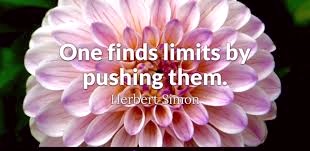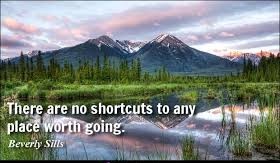Well-intentioned coaches or teachers or parents often demand we try new activities, pulling us out of our comfort zone. They’re hoping to help us increase our skills and experience, yet if it’s too much of a stretch for us, we’ll resist.

I’ve pushed myself academically, athletically, and emotionally as long as I can remember. So naturally, once I discovered the possibility of improving my eyesight, I took my usual approach of pushing myself, pretty fiercely. I read every book I could find about vision improvement, most more than once, and did swinging and palming and the other classic Bates practices with almost a desperate attitude, determined to “get it right”.
Looking back, someone should have hit me over the head with one of those signs which says “Easy does it!”. I was not being gentle with myself at all, nor with my strained visual system which had been trying so hard for me all these years. So of course I made slow progress. Once again my vision improvement was acting as a metaphor for the rest of my life, where I often pushed past my limits, then injured myself or got upset and needed to take “down time” to recover.

Knowing what I know now, my 2 biggest mistakes in improving my vision were 1) not paying enough attention to how my eyes and visual brain felt, and 2) avoiding using the eye chart, for years. Yes, there are people who do nothing different, then hope for change — this isn’t my pattern. I can push myself too hard, then be forced to take a break only when I reach a personal limit.
Finally I’ve learned to stop what I’m doing if my eyes are complaining, instead of ignoring them. I’d like to think I’m treating them as cherished partners and helpers, not like unfeeling machines who never break down. And after actively ignoring the eye chart, since it upset me to see how poor my vision actually was, I now use it for at least a few minutes every day. I knew I had a long way to go to achieve consistently clear vision, which is all the more reason to get started!
If you’re hoping to improve your physical fitness, there are some useful parallels to eyesight improvement. You don’t go to the gym and start with heavy weights if you’ve never worked out before — you’ll hurt yourself. Similarly, it’s not a good idea to take off strong glasses and try to function, when you can’t see much and have no visual confidence. You’ll need to try very safe activities first with no glasses, then gradually lower your lens prescription bit by bit.

Recently I had a minor injury in the large joint on top of my foot, below my big toe, with swelling and soreness. This seriously tried my patience, as I’m quite active. I kept testing it, hoping to exercise it, or to quickly bound down stairs, but it hurt too much. Why was it taking so long to heal? I didn’t want to injure it further, so I had no choice but to take it easy.

My foot is better today than it’s been in 2 weeks, and I’m optimistic that I’ve finally turned the corner and it will continue to recover, when it seemed to be stuck permanently in the injured state. (This may have been a growth period for my attitude as much as for my foot.) I’m grateful that my healthy body knows how to heal, if I just stop pushing it so hard. And so do my eyes, which seem to be noticing more every day. Easy does it!
get help on our Facebook Group!
I wore strong glasses, then contact lenses, from age 5 into my 40s. While making many mistakes, eventually l learned how to improve the way I use my eyes and to see in a more relaxed, healthy manner. It is my pleasure to coach others to do the same. Visit me at https://NancyLNeff.com.
